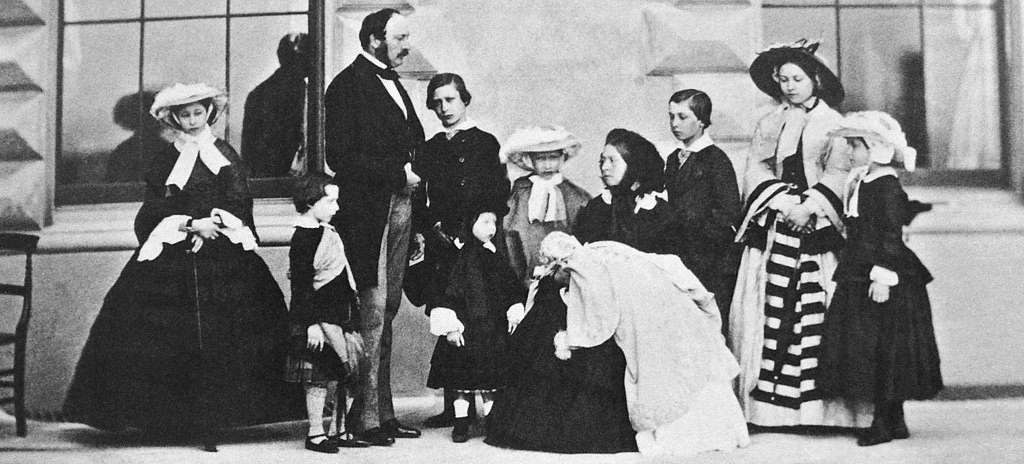Who was Queen Victoria?
Nothing was destined to reign for the 18-year-old girl who ascended the throne in 1837. Queen Victoria, Queen of England, nevertheless left her mark on her time and her empire for 63 years.
Like her great-granddaughter Elizabeth II, who only came to the throne due to the abdication of her uncle Edward VIII, Victoria was not destined to rule. Born May 24, 1819, she is the daughter of Prince Edward, Duke of Kent, fourth son of King George III.
Victoria’s father and grandfather both died in 1820 and Victoria did not become queen until the death of her three uncles: Prince Frederik who died in 1837, King George IV who reigned until 1830 and King William IV who died in 1837. None having legitimate heirs, it was Victoria who ascended the throne on June 20, 1837.
Queen Victoria: 63 years on the throne of England
Queen Victoria reigned for 63 years and seven months, the second longest reign in UK history after that of Elizabeth II. When Victoria ascends the throne, the monarchy is in dire straits after the chaotic reigns of her mentally ill grandfather King George III and her two willingly extravagant uncles. The reign of Victoria profoundly marked British society and saw an unprecedented expansion of the Empire which was, at the beginning of the 20th century, at the top of the world.
- May 28, 1842: Queen Victoria was the victim of an attempted murder while traveling in a carriage. In total, the sovereign will be the victim of eight assassination attempts during her reign.
- 1845: Ireland is hit by an unprecedented famine that causes the death of more than a million people. The British government is widely criticized for its management of the crisis. The queen will make a personal donation of 2,000 pounds at the time, a sum which today corresponds to approximately 185,000 euros.
- 1867: Queen Victoria supports the “Reform Act” which will double the number of voters in the Kingdom. More than two million people can now vote, including many men from the working classes. In 1884, with the “Third Reform Act”, the percentage of British citizens who could vote rose to 60% of the population.
- January 1, 1877: When the English East India Company is dissolved, the British protectorates are incorporated into the Empire, Victoria becomes Empress of India.
Read also: Longest Reigning European Monarchs (Emperors, Kings and Princes)

The Queen Victoria photographed by Alexander Bassano, 1882. Alexander Bassano, Public domain, via Wikimedia Commons
Grieving, depressed and secluded
This beautiful romance was however cut short by the brutal death of Albert
This beautiful romance was however cut short by the brutal death of Albert, carried away in December 1861 by an attack of typhoid fever. This death deeply affected Queen Victoria. Devastated by depression, she retired to the medieval fortress of Windsor, where she isolated herself in grief and mourning. Sacrificing her duties as sovereign and mother, she even thought for a time of abdicating. The one who was nicknamed the “widow of Windsor” hardly left her seclusion except to go to her manor house in Balmoral, Scotland, or her residence in Osborne, Isle of Wight.
Her first valet
She then approached one of her servants, the Scotsman John Brown, who had been the late Prince Albert’s first valet. Combined with her isolation, this relationship, which gave rise to many rumors (there was even talk of a secret marriage), contributed to tarnishing the Queen’s popularity and nurturing a temporary feeling of republicanism, exploited by the radical Charles Dilke. Life, however, gradually resumed its course. In 1866, the Queen decided to open the session of Parliament and pledged the following year to support the great electoral reform championed by the Conservatives Lord Derby and Benjamin Disraeli. The latter played a decisive role in Victoria’s return to grace.
From his romantic and tumultuous youth, Disraeli had retained ambition and passion. Although conservative, he pursued a policy of social reform and engaged the country in a vigorous campaign of colonial expansion. In Afghanistan, in Zululand, in Sudan, Victoria supported these “small wars”, which according to her worked with the size of the country. Disraeli, who had won her confidence, was gradually leading the queen back onto the public road. In April 1876, he got Parliament to pass the Royal Titles Act, which made Victoria Empress of India. The sovereign, also queen of Canada and Australia, now reigned over more than 350 million subjects, or a quarter of the world’s population. Victoria was passionate about this new function, applied herself to the study of the Hindi and Urdu languages, and surrounded herself with Indian servants. The initiative, which allowed the queen to regain the confidence of the country, was also the source of a deep friendship with Disraeli.
What is the relationship between Queen Victoria and Elizabeth II?
Queen Elizabeth II is a direct descendant of Queen Victoria who was her great grandmother. But the two women have more than one thing in common.
Starting with an exceptionally long reign, but also by the vagaries of history which led them both to the throne when nothing predestined them there. Two exceptional destinies for two leading women.
Albert, Victoria and their nine children, 1857. Left to right: Alice, Arthur, Prince Albert, Albert Edward, Leopold, Louise, Queen Victoria with Beatrice, Alfred, Victoria, and Helena. Caldesi and Montecchi (fl.1857-67), Public domain, via Wikimedia Commons
How did Queen Victoria die?
Victoria died of a cerebral haemorrhage, which is a type of stroke. Queen Victoria died on January 22, 1901 at Osborne House on the Isle of Wight, surrounded by her son the future King Edward VII and one of the grandsons William II who would become Emperor of Germany. In accordance with his wishes, his military funeral was held on February 2 in St George’s Chapel at Windsor Castle.
The Queen’s body is on public display for two days and she is buried alongside her late husband Albert in the Royal Mausoleum at Frogmore Estate. On her death, Queen Victoria became a legend and left an indelible mark on British society and the hearts of her subjects.
The descendants of Queen Victoria: who succeeded her?
Queen Victoria and her husband Prince Albert of Saxe-Coburg-Gotha had nine children (four daughters and five sons): Victoria, Edward VII, Alice, Alfred, Helena, Louise, Arthur, Leopold and Beatrice. Rarely, all the couple’s children have reached adulthood.
According to the order of succession to the British throne fixed by the Act of Establishment of 1701, it is the eldest of the boys who will be crowned on the death of Queen Victoria under the name of Edward VII (1841-1910). His son George V, his grandsons Edward VIII and George VII and finally his great-granddaughter Elizabeth II will succeed him. The current Queen of England is therefore a direct descendant of Queen Victoria. The latter is nicknamed “the grandmother of Europe” because she counts among her descendants more than thirty European monarchs. In England of course, but also in Spain, Yugoslavia, Norway, Romania, Germany or Greece.
Marie Therese of Austria, The mystery the erased French Queen (Wife of Louis XIV)
Sources: PinterPandai, The Royal Household, Britannica
Photo credit (main picture): Author: Charles Robert Leslie (1794–1859) (Public Domain) Source: https://collections.vam.ac.uk/item/O16729/queen-victoria-in-her-coronation-oil-painting-leslie-charles-robert via Wikimedia Commons
Main photo description: Queen Victoria at her coronation in 1838 wearing her robes (painted some time after the event).




